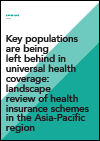What's New
Displaying results 321 - 330 of 4913

Resource | Publications,
UNICEF’S Gender Policy 2021-2030 and accompanying Action Plan 2022-2025 articulate UNICEF’s commitments to promoting gender equality across programmes, workplaces and practices around the world.

Resource | Publications,
The WHO Global strategy on human resources for health: workforce 2030 encourages development partners and global health initiatives to leverage their support to health systems in countries to sustainably strengthen the health workforce. To assess the impact of these investments, a methodology was developed and pilot tested by WHO.

Resource | Publications,
This module introduces the principles of competency-based education (CBE) and the competency model used within the WHO Global Competency and Outcomes Framework for UHC which is oriented towards the performance of the practice activities relevant for the scope of practice and service package. It maps the HIV services from the UHC Compendium with the practice activities in the Global Competency and Outcomes Framework for UHC; in so doing, it provides a reference for the content and outcomes to be integrated into competency-based curricula.

Resource | Publications,
The Global Competency Framework for Universal Health Coverage identifies the health worker competencies towards the achievement of UHC organized within six domains: people-centredness, decision-making, communication, collaboration, evidence-informed practice and personal conduct. This framework has been developed through the lens of 12-48 month pre-service education pathways. With this framework, WHO sets out its recommended approach to competency-based health worker education outcomes; in so doing, it also provides conceptual and terminological clarity.

Resource | Publications,
The goal of this Global Competency and Outcomes Framework for UHC is to advance improvements in health and progress towards UHC through aligning health worker education approaches with population health needs and health system demands. More specifically, the primary objective of this document is to provide guidance for the specification of pre-service and in-service competency-based education outcomes for health workers, which in turn inform the development of relevant curricula, learning activities and assessment approaches.

Resource | Publications,
Modern, effective contraception is widely — though not universally — available. Why, then, are half of all pregnancies unplanned, and many of them unwanted?
This is a reminder of how many people ,especially women and girls, are limited in exercising their basic rights. It is a sign that gender discrimination continues to wind through the lives of women and girls, as well as transgender, non-binary and gender expansive people. It points to deep gaps in rights and justice, gender equality, human dignity and broader social well-being.
So many unplanned and unwanted pregnancies raise questions about how much the rights and potential of more than half of humanity are prioritized and valued. They signal that the world could fail to reach its development goals for health, education and gender equality, derailing the shared ambitions of the international community.

Resource | Publications,
Universal health coverage is guided by the principle that individuals and communities receive the services they need, including essential good-quality health services, without suffering financing hardship. The establishment or expansion of government-sponsored health insurance is often promoted as the main vehicle to finance universal health coverage.
Resource | Presentations,
Get an overview of the HIV/AIDS situation for People Living with HIV (PLHIV) in the Asia-Pacific region. Browse and view tables, charts and graphs illustrating data on PLHIV treatment, women living with HIV and reproductive rights, and punitive laws hindering the HIV response among PLHIV.
Resource | Presentations,
Get an overview of the HIV/AIDS situation for Adolescents (10-19 yr) in the Asia-Pacific region. Browse and view tables, charts and graphs illustrating data on HIV Prevalence and National Response among Asia-Pacific countries for Adolescents.

Resource | Publications,
Almost half of the deaths worldwide caused by TB in 2019 occurred in the WHO South-East Asia Region, home to around a quarter of the global population. Maintaining robust progress in this Region is therefore essential if the global goal of ending the TB epidemic is to be realized. Despite substantial gains made in the Region, the threat to health worldwide posed by the COVID-19 pandemic has the potential to reverse these gains and eclipse the focus on the global TB emergency.
While continuing to tackle COVID-19-related challenges, countries will need to rapidly and urgently deploy supplementary measures to address the large numbers of missed cases, poor treatment outcomes and, potentially, a higher TB burden.
The Regional Strategic Plan towards Ending TB in the Region 2021–2025 clearly articulates priority interventions, analyses the challenges, bottlenecks and opportunities, and focuses on implementation considerations in the Region.





